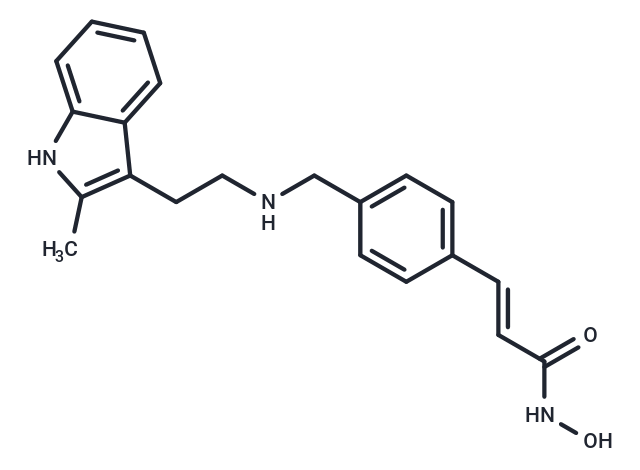购物车
- 全部删除
 您的购物车当前为空
您的购物车当前为空

Panobinostat (NVP-LBH589) 是一种广谱的 HDAC 抑制剂 (IC50=5 nM),具有口服活性和非选择性。Panobinostat 具有抗肿瘤活性,可以诱导细胞凋亡和自噬。

Panobinostat (NVP-LBH589) 是一种广谱的 HDAC 抑制剂 (IC50=5 nM),具有口服活性和非选择性。Panobinostat 具有抗肿瘤活性,可以诱导细胞凋亡和自噬。
| 规格 | 价格 | 库存 | 数量 |
|---|---|---|---|
| 1 mg | ¥ 153 | 现货 | |
| 5 mg | ¥ 335 | 现货 | |
| 10 mg | ¥ 526 | 现货 | |
| 25 mg | ¥ 933 | 现货 | |
| 50 mg | ¥ 1,530 | 现货 | |
| 100 mg | ¥ 2,570 | 现货 | |
| 200 mg | ¥ 3,790 | 现货 | |
| 500 mg | ¥ 6,220 | 现货 | |
| 1 mL x 10 mM (in DMSO) | ¥ 375 | 现货 |
| 产品描述 | Panobinostat (NVP-LBH589) is a broad-spectrum HDAC inhibitor (IC50=5 nM) with oral activity and non-selectivity. Panobinostat has antitumor activity and induces apoptosis and autophagy. |
| 靶点活性 | HDAC (Reh cells):20 nM, HDAC (MOLT-4 cells):5 nM |
| 体外活性 | 方法:37 种肺癌细胞系用 Panobinostat (0-800 nmol/L) 处理 48-72 h,使用 MTT 方法检测细胞活力。 结果:Panobinostat 对人和小鼠的肺癌细胞系表现出强大的抗增殖活性和细胞毒性。[1] 方法:人 ALL 细胞 MOLT-4 和 Reh 用 Panobinostat (10-100 nM) 处理 24-72 h,使用 Flow Cytometry 检测细胞凋亡情况。 结果:Panobinostat 以时间和剂量依赖的方式诱导 MOLT-4 和 Reh 细胞的凋亡。[2] |
| 体内活性 | 方法:为检测体内抗肿瘤活性,将 Panobinostat (20 mg/kg) 腹腔注射给携带人 SCLC 肿瘤 H526、BKT、RG1 或 H69 的 SCID 小鼠,每周五次,持续两周。 结果:Panobinostat 显著减缓源于 SCLC 细胞的肿瘤的体内生长并诱导缓解。[1] 方法:为研究对中风后增强运动功能恢复的潜力,将 Panobinostat (3-10 mg/kg) 腹腔注射给中风的 CD-1 小鼠,每两天一次,持续十天。 结果:体育锻炼与 Panobinostat 的结合都不会对中风后小鼠的运动恢复产生实质性影响。Panobinostat 治疗加上有限的身体康复不太可能为患有运动功能障碍的中风幸存者提供治疗方式。[3] |
| 细胞实验 | Blasts from peripheral blood of 2 patients and from bone marrow of 4 patients were isolated with Ficoll-Hypaque, put in culture at a density of 500?000 cells/mL with RPMI-1640 medium containing 10% fetal bovine serum and 50 units/mL penicillin and streptomycin, and treated with different doses of LBH589 (0-100 μM) for up to 48 hours [1]. |
| 动物实验 | AE17 and TC-1 cancer cells (1 × 10^6 cells) were injected into the flanks of adult female C57Bl/6 mice and severe combined immunodeficiency (SCID) mice. M30 (10 × 10^6 cells), A549 (5 × 10^6 cells), H69 (2.5 × 10^6 cells), BK-T (6.5 × 10^6), H526 (10 × 10^6), and RG1 (10 × 10^6) cells were also injected, but in the presence of matrigel (BD Biosciences), into the flanks of SCID mice. There were 5 to 10 mice in each treatment group. The experiments with the A549 and H69 cell lines were repeated to ensure the statistical consistency of the results. Experiments were terminated when the tumors in the control mice had grown to a size that threatened the quality of life of the mice. When tumors reached 100 to 500 mm3, panobinostat was administered via i.p. injections (10–20 mg/kg) on a daily schedule (5-days-on, 2-days-off regimen) for the entire duration of the experiment. Control mice received i.p. injections with dextrose 5% in water ("vehicle treatment"). Every tumor was measured with a caliper at least twice weekly. For evaluation of the effects of combination therapy on SCLC-derived tumors, SCID mice with H69 tumors were administered panobinostat as described above. Three days after the initiation of panobinostat, and again 1 wk later, etoposide (40 mg/kg) was administered i.p [3]. |
| 别名 | 帕比司他, NVP-LBH589, LBH589 |
| 分子量 | 349.43 |
| 分子式 | C21H23N3O2 |
| CAS No. | 404950-80-7 |
| Smiles | Cc1[nH]c2ccccc2c1CCNCc1ccc(\C=C\C(=O)NO)cc1 |
| 密度 | 1.241 g/cm3 (Predicted) |
| 存储 | Powder: -20°C for 3 years | In solvent: -80°C for 1 year | Shipping with blue ice. | ||||||||||
| 溶解度信息 | H2O: < 1 mg/mL (insoluble or slightly soluble) 10% DMSO+40% PEG300+5% Tween 80+45% Saline: 6.4 mg/mL (18.32 mM), In vivo: Please add co-solvents sequentially, clarifying the solution as much as possible before adding the next one. Dissolve by heating and/or sonication if necessary. Working solution is recommended to be prepared and used immediately. Ethanol: < 1 mg/mL (insoluble or slightly soluble) DMSO: 16.67 mg/mL (47.7 mM) | ||||||||||
溶液配制表 | |||||||||||
DMSO
| |||||||||||
评论内容